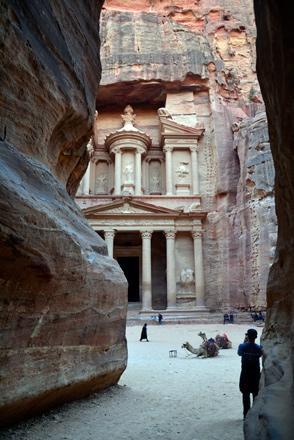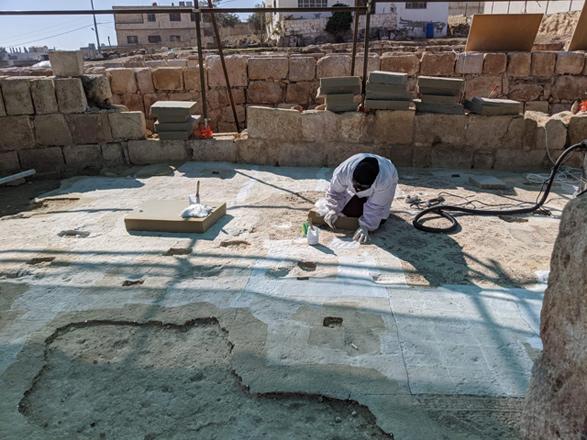You are here
UNESCO project envisions twin goals of heritage preservation, job creation
By Batool Ghaith - Apr 13,2021 - Last updated at Apr 13,2021

A view of Petra’s Treasury, the rose-red city’s iconic façade, from the Siq, the natural gorge leading to the ancient site (JT file photo)
AMMAN — UNESCO project “Employment Opportunities for Cultural Heritage Safeguarding in Jordan” aims to invest in cultural heritage preservation while creating short-term job opportunities for Jordanians and Syrians, according to Giorgia Cesaro, senior project officer.
The project, started in 2019, seeks to contribute to sustainable socio-economic development by utilising culture as a source of resilience, Cesaro said.
As the project is still ongoing, UNESCO has modified its programmes to provide a healthy working environment during the pandemic. To make this possible, UNESCO ensures that its projects comply with Jordan's Ministry of Labour regulations about the safety measures to be implemented, Cesaro said.
“The project's goal will be met by basic restoration and protection of two cultural heritage sites, the village of Rihab (Mafraq) and the Petra World Heritage Site (Maan), for heritage preservation and tourism purposes in addition to the development of short-term job opportunities for Syrian refugees and Jordanians living in host communities through a Cash for Work approach,” Cesaro told The Jordan Times.
The project always targets the most vulnerable segment of the population, such as the local communities living in the vicinity of the site in Petra and vulnerable Jordanians and Syrian refugees living in the vicinity of Rihab, Cesaro said.
“The project is also supporting the Department of Antiquities in ensuring better preservation of heritage sites in Jordan and their improved presentation for tourism purposes,” Cesaro added.
The project is targeting the provision of short-term job opportunities to 270 workers, 150 in Petra and 120 in Rihab, of which 20 per cent will be women and 4 per cent will be people with disabilities. In Rihab, the project’s target is to engage up to 50 per cent Syrian workers,” Cesaro said.
At the Petra World Heritage Site, two tourist trails are being rehabilitated and better presented to tourists, and the top of the Siq (the natural gorge leading to the ancient site) is being cleaned from debris and loose rocks to better protect the site against rock fall hazard, the project officer said.
In Rihab, activities are taking place at the Church of St. Mary as well as the Church Complex of St John the Baptist and Priests Sergius and Procopius.
“The key goal is to keep heritage buildings in good condition in the areas where they are being worked on (ancient Nabataean structures, Byzantine mosaics, etc…). Second, through the delineation of tourist paths and the preparation of interpretation panels for the places where work is being done, measures are made to make the sites more understandable for tourists,” Cesaro added.
The Cash for Work Water (C4WW) project is implemented by the German Agency for International Cooperation (GIZ) and it is commissioned by the German Federal Ministry for Economic Cooperation and Development.
Aladdin Hiyasat, component manager of soil erosion prevention measures at GIZ, said: “The supported measures benefit refugees and host communities alike. This project contributes to rehabilitating antiquity sites, establishing a secure water supply and employing refugees and people in need from the host communities. It also promotes social cohesion and sustainable development in the region.”
According to Hiyasat, GIZ and UNESCO jointly implement the measures in Petra and Rihab.
“The project is committed to delivering medium and long-term employment prospects, mainly by providing Post Employment Services and on job trainings. The project provides short term opportunities in the areas of preservations and rehabilitation of antiquity sites and conservation of water dams through soil erosion prevention measures,” Hiyasat told The Jordan Times.
Throughout both components, more than 9,000 work opportunities have been provided to vulnerable Jordanians and Syrian refugees, of which 20 per cent are females, Hiyasat noted.
The Association for Volunteers in International Service (AVSI) is a nonprofit organisation which partnered with the UNESCO on the project. AVSI’s activities focus on supporting the most vulnerable groups among refugees and hosting communities, according to its website.
Nicola Orsini, AVSI country representative, highlighted the importance of the partnership as the project had a great positive impact on the economic situation by creating jobs for the most vulnerable.
Orsini indicated that the project helps raise awareness of the local communities and Syrian refugees regarding the importance and value of cultural heritage.
“The involvement of women is really important as it has a great impact on their lives as they are able to provide for themselves and their families, therefore becoming vital members of society. And they gain new skills at the same time,” he added.
Related Articles
AMMAN — The Association of Volunteers in International Service (AVSI Foundation) is an Italian NGO which launched a series of projects aimin
AMMAN — In the hills of Rihab, a village a few kilometres away from Mafraq, the remains of several ancient churches can be found, each with
AMMAN — After a busy morning of work along the back-trail to the Monastery in Petra, Yousef Ahmed Hasanat took a break in the shade to share















